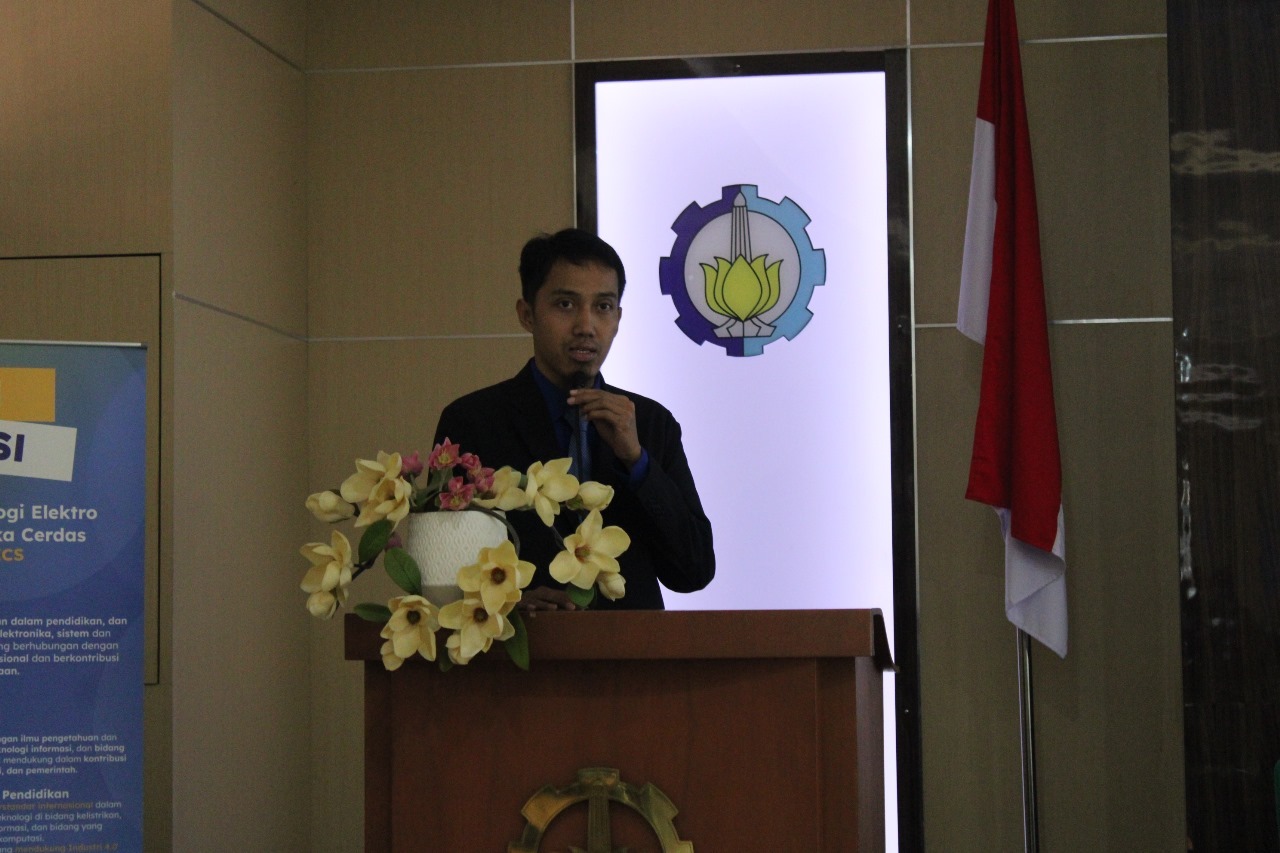ITS New Doctor Innovates Self-Supervised Learning for 3D Data

Dr Oddy Virgantara Putra SKom MT while explaining how the self-supervised system works in his research
ITS Campus, ITS News — A graduate of the Electrical Engineering Department of Institut Teknologi Sepuluh Nopember (ITS), Dr Oddy Virgantara Putra SKom MT has developed a practical self-learning framework to overcome data inaccuracies. The framework combines denoising and self-learning techniques to significantly improve the accuracy of three-dimensional (3D) object recognition.
Oddy explained that the framework he developed can reduce noise and improve the quality of 3D point cloud data, a set of points in 3D space that represents the surface shape of an object or environment. “This is achieved through the denoising module, which consists of ScoreNet and Guided Filter,” said the man who is also a lecturer at Informatics Engineering Universitas Darussalam Gontor, Ponorogo.
According to Oddy, this module isolates valuable information and enhances important details from 3D point cloud data. The enhanced data is then used to train classifiers based on the GDANet architecture, an attention network designed to better understand 3D object representations through geometry separation.

Dr Oddy Virgantara Putra SKom MT during his dissertation presentation in the Open Session of Doctoral Promotion at the Department of Electrical Engineering ITS
Furthermore, this architecture utilizes a two-function operation or overparameterized convolution (DOConv). This convolution layer is designed to improve the performance of convolutional neural networks by adding additional parameters without increasing computational complexity during inference. “It is used to capture complex features important for accurate classification,” he explained.
The man from Kediri added that he also developed a self-learning framework called Adaptive Dynamic Loss Weighting for Cross-Modal Contrastive Point Cloud Learning (AdaCrossNet). This framework is intended to improve representation learning. “AdaCrossNet is designed to reduce the need for manual annotation through dynamic intra-modal and cross-modal contrastive learning,” he said.
Test results showed that the framework developed by Oddy achieved excellent performance on various benchmark datasets. The denoising module achieved a Hausdorff Distance score of 0.177, which is the maximum distance between a specific geometry corner point and the nearest corner point in the reference geometry. The classifier achieved 90.7 percent accuracy on ModelNet40 and 96.7 percent on the Human Pose Dataset.

Dr Oddy Virgantara Putra SKom MT, while showing his dissertation in the Open Session of Doctoral Promotion at the Department of Electrical Engineering ITS
Also mentioned, one of the main innovations of this research is the use of the Self-Supervised Learning (SSL) approach to recognize essential features from 3D point cloud data. This data is captured by Light Detection and Ranging (LiDAR), a remote scanning technology that uses lasers to measure the distance of an object or surface with great precision.
This technology can span everything from developing more accurate health monitoring systems to creating more intuitive interfaces for human-computer interaction. In healthcare, this technology can be used to analyze patient movements. “It can be used during rehabilitation or to detect changes in posture,” Oddy added.
The results of this research can be utilized to support Sustainable Development Goals (SDGs) 3 and 9, namely healthy living and welfare, as well as the goals to build infrastructure, innovation, and industry. Through this research, Oddy hopes his findings can support advancements in incorporating sensors to improve object and human recognition. “So that more people can be helped,” he said optimistically. (ITS Public Relation)
Reporter: Harri Raditya Ardianto
Translator: Lael Soebakir
Related News
-
ITS Lecturer Introduces Madurese Culture to the International Stage
ITS Campus, ITS News — Continuing to show local wisdom to the world community, this time a lecturer from the Department
March 08, 2025 16:03 -
ITS Researchers Remind TKDN is Crucial for Economic Independence
ITS Campus, ITS News — The Domestic Component Level (TKDN) is the key to restoring the glory of the Indonesian
March 08, 2025 16:03 -
Strengthening Quality Education, ITS Professor Develops Adaptive Technology for Students
ITS Campus, ITS News — Differences in students’ abilities in understanding lessons are often a challenge for teachers in the classroom.
March 08, 2025 16:03 -
ITS Graduates Create Reverse Logistics Model for PET Plastic Waste Recycling
ITS Campus, ITS News — Doctoral graduate from the Department of Industrial and Systems Engineering, Sepuluh Nopember Institute of Technology (ITS) Dr. Yuniar
March 08, 2025 16:03
